Leaf Pulling and Canopy Management: Let the Sun Shine In
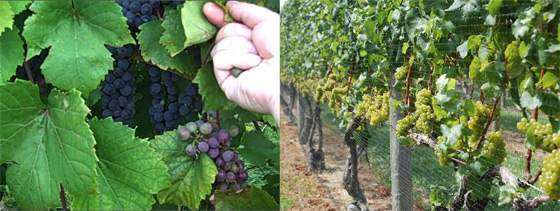
Buried grapes in the research vineyards at Cornell Orchards, Ithaca, NY (left) and grapes more fully exposed to the sun at Peconic Bay Winery, Peconic, NY (right)
By Tom Mansell, Science Editor
As I checked my Twitter feed over the past few days, I noticed lots of tweets about the upcoming harvest from winemakers and growers.
See the following from Lucas Vineyards winemaker Jeff Houck and Fox Run Vineyards owner Scott Osborn:


Apparently many places are doing some post-verasion leaf removal, as recently discussed on this site. It got me thinking about what's actually happening inside the grape when all of a sudden it's allowed to bask in the sunlight.
Vines, like wines, should be balanced
When we think about yield from a grapevine, we need to consider both fruit and vegetative growth (e.g., shoots, leaves, etc.). During the growing season, depending on rootstock, trellising, soil conditions, nitrogen availability, water availability and other variables, the balance between vegetative growth and fruit can tip towards vegetative, leading to a canopy that shades fruit, leading to less fruit development. This leads to more vegetative growth, and the cycle continues.
In particularly vigorous growing seasons, especially between veraison and harvest, temporary canopy management may be necessary to improve what's known as the microclimate of the grapes.
So why pull leaves?
Leaf removal has several purposes:
- It allows more air to flow through the fruiting zone. This is particularly beneficial in humid climates (e.g., the Finger Lakes) because it keeps grapes drier, reducing susceptibility to fungi like Botrytis.
- Sunlight warms the berries up. Increased temperature in the fruiting zone increases enzymatic activity inside the berry, leading to, as viticulture specialist Hans Walter-Peterson commented in this thread, increased degradation of acids. The increased temperature also tends to concentrate the berries, leading to a concentration of flavor and aroma precursors, as well as sugars.
- UV light affects synthesis of certain compounds. Sunlight shining in on berry skins causes them to produce more flavonoids, natural sunscreen compounds that also happen to be important to color (anthocyanins) and flavor compounds (quercetin and catechins).
So leaf removal can improve desirable characteristics in the berries as well as help prevent rotten fruit, but it is a temporary solution and likely something that has to be done every year. Managing the canopy by other, more long-term techniques is a preferable solution.
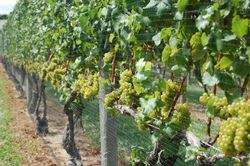 For example, different vine-training systems can affect vine vigor throughout the growing season and allow for optimal sun exposure. On Long Island, for example, vertical shoot positioning (VSP) is often used to allow for maximum sunlight. As you can see in the picture on the right, come harvest season there is also quite a bit of leaf and shoot thinning that goes on.
For example, different vine-training systems can affect vine vigor throughout the growing season and allow for optimal sun exposure. On Long Island, for example, vertical shoot positioning (VSP) is often used to allow for maximum sunlight. As you can see in the picture on the right, come harvest season there is also quite a bit of leaf and shoot thinning that goes on.
Excessive sun exposure can lead to sunburn (literally) on grapes in some warmer climates. In fact, too much warmth actually can lead to degradation of anthocyanins, which can reduce color in grapes. Napa growers often worry about the amount of shade on their grapes. In cool climates like New York state, though, we generally want all the sun we can get.
Another point to consider is that increased grape exposure makes berries visually available and attractive to birds, who love grapes just as much as humans (so much so that they rarely wait for harvest and fermentation…), thus the bird netting in the picture on the right. I'm told that turkeys LOVE gewürztraminer grapes.
At any rate, whatever winegrowers can do to keep those grapes disease-free and speed up the ripening process is OK by me. Let's hope the weather in September stays nice and dry… and brings us lots of sun.
Further reading:
Smart and Robinson, Sunlight into Wine, Winetitles, 1991
Pereira et al., "Microclimate influence on mineral and metabolic profiles of grape berries", J. Ag. Food. Chem., 2006 (abstract)
Matus et al., "Post-veraison sunlight exposure induces MYB-mediated
transcriptional regulation of anthocyanin and flavonol synthesis in
berry skins of Vitis vinifera", J. Experimental Botany, 2009(full text)









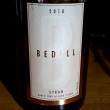
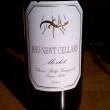

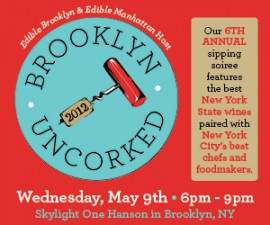

Thanks for the first post, Tom.
I’ve always been surprised by the completely different canopy systems in the Finger Lakes vs. Long Island given the similarities in terms of cooler regions and humid ones (though moreso with Long Island).
Given the sometimes-struggle to ripen red varieties in the Finger Lakes, why aren’t more vineyards pulling leaves more agressively, similar to how they do things here on Long Island? Is it just a matter of the time/costs associated?
I’ve also heard at least one winemaker in the Finger Lakes contend that by fully exposing the fruit to the sun (he was talking about white wine grapes) you lose “tons of aromatics.”
Long Island winemakers would counter by saying that they’d rather have ripe fruit with slightly lower aromatics than underripe fruit with high aromatics.
I guess it goes back to the balance you started the piece with.
I think the practice is pretty straightforward with regard to red grape maturation and ripening, although on Long Island we’ve found that there is a greater effect on wine quality when we remove the leaves earlier in the season, beginning right after set. Some varieties require more than a few passes throughout the season. )
)
In terms of the whites, specifically for us - Sauvignon Blanc - if losing “tons of aromatics” means losing a lot of green, herbaceous aromas and flavors then yes that is what I want. I’d rather have riper fruit with more of a balance between tropical and grassy flavors than a wine dominated by methoxypyrazines. ( I can buy a New Zealand wine if that’s what I’m looking for
My understanding of Riesling is that over-exposure to sunlight causes an increase in the petrol aromas or 1,1,6-Trimethyl-1,2-dihydronaphthalene - TDN. In cooler years it might be more advantageous to expose the fruit than in warmer years. Sauvignon Blanc doesn’t have these same issues and we need to expose the fruit both for disease control as well as for ripening.
Rich:
It’s true that sun exposure upregulates carotenoids, which break down during ripening to form TDN (and break down in the bottle, hence the petrol in aged rieslings), but this can also be linked to drought stress (tough to decouple). Some “aromatics” could break down with increased enzymatic activity (like malic acid).
I agree that trellising is definitely cultivar and rootstock specific as well to control vine vigor. Part of my point was that leaf removal is a “band-aid” solution and controlling vine vigor and canopy has other, more permanent solutions.
Tom - thanks. Well for us it’s definitely not a band-aid - its an integral part of our canopy management and necessary for a quality wine program. Although there are differing opinions on how and when (as well as how much) to do it, most all growers here would agree that you cannot just rely on a balanced canopy alone to expose the fruit properly.
Tom,
Thanks for this. I always find your post very interesting and I always learn from them.
I too always found it interesting how one vineyard would have one canopy and someone else completely different. I guess it would be safe to assume that canopy’s could differ from block to block as well?
I look forward to learning more from you.
Michael: Wait until you are up in the Finger Lakes for TasteCamp. Actually, might not be much to look at yet, but if you see pictures of the vineyards, they tend to look completely wild and unkempt compared to the highly manicured vineyards down here. It’s striking.
Hi all, I thought I would chime about some of the unkept finger lakes vineyards. I might speculate that many of the wild looking vineyards of the finger lakes are probably hybrid or even native vines. Vinifera vines on VSP or Scott Henry systems in the finger lakes are generally pretty tidy. While I think there is a tendency to not completely defoliate the fruit zone, the nature of the trellis system demands shoot positioning, leaf removal, and some hedging. The nuts and bolts of the training systems on LI and FL are similar.
Tom,
Can you clarify what you mean when you state that leaf pulling may be a temporary solution?
We do not think of leaf pulling as a device to control vine vigor. But as you stated there are definite and measurable benefits to leaf pulling. Here is a recap that includes what you and Rich have reviewed already, as the benefits of leaf pulling:
- increased ventilation dries up condensation and dew faster thereby reducing the downy mildew pressure.
- exposure to sunlight suppresses the powdery mildew inoculum which has been shown to be sensitive to UV light.
- sunlight metabolises better flavors in any fruit. When buying peaches we select instinctively the ones with red cheeks, those exposed to sunlight, rather than the yellow ones that grew in the shade. Same is true with grapes.
-as Rich explained the metoxypirazines are depleted at twice the rate when leaves are pulled. See a recent article in Vineyard and Winery management about pyrazine depletion in Cabernet Franc with and without leaves pulled.
- as you and Rich stated there are a number of beneficial reactions insde the berry resulting in more complex flavors.
On Long Island we have not experienced any sun burning of the fruit when we pull at and after fruit set. The sooner we pull the better for prophylactic reasons as explained above.
In Germany they are experimenting, successfully I might add, with leaf pulling at flowering and before fruit set.
So the bottom line is that for some of us leaf pulling is neither a temporary practice nor a band aid but an intrinsic part of managing the quality of our wines for better outcomes.
Jeff:
I meant more to point out how exposed the grapes are famously very exposed in Long Island in general, and yes, you’re right, that picture is a hybrid (DeChaunac, I think? I can’t see the red in the stems, but the clusters look too loose to be Foch).
Charles:
Thanks for weighing in. The benefits I presented are, in general, benefits of increased sun exposure and not necessarily ONLY possible using leaf removal. I presented leaf removal because it is something that a lot of growers are doing, but it can be labor-intensive, especially if you do it by hand. If you talk to viticulturists, it’s certainly not the only form of canopy management.
I would argue that more long-term methods of canopy management can effectively control vine vigor and reduce the need for pulling. Canopy division, nitrogen management (by managing fertilizer and introducing nitrogen-scavenging cover crops), and water management (not really too applicable in non-irrigated areas) can help control vegetative growth as well.
Hedging can actually lead to decreased winter-hardiness and can lead to increased growth of laterals, which could actually increase shading!
Rich makes a good point in that there’s no guarantee that site- and cultivar-appropriate training and the other methods I mentioned will guarantee proper microclimate, but why not control growth in a more systematic way and save money and labor on leaf-pulling?
Tom,
Leaf pulling in our environment presents advantages that are well defined, irrespective of excessive vigor.
You may make your case on managing excessive vigor, but it is too limiting to think of leaf pulling as only a vigor management activity. Even in vines that are balanced and that are not growing too vigoroulsy the benefits from leaf pulling, outlined previously, will justify doing it.
Somehow I do not understand that leaf pulling is either temporary or a band aid. Yes it raises the cost of growing grapes, but if the increase in quality is commensurate then the extra cost may be justified.
What I question is leaf pulling this late in the season, as the fruit is now immune to the mildews, if it is still clean. The sun exposure is reduced as the days are a lot shorter. If the cost is going to be incurred anyway why not do it as early as possible to get the full benefit of a proven practice.
I fall in the “leaf pulling and controlling vine vigor are two separate things” camp.
The argument that leaf pulling is costly and labor intensive is negated by the increased efficiency of a manual harvest when the fruit is easily seen and easy to get to.
BTW Scott Henry trellis systems never look as neat as they do in text books. Shoots tend to not want to grow downward and I assume keeping that system clean is extremely labor intensive.
Discussions like this are extremely appreciated by future growers like myself, thanks all who chime in.
I think I may have been slightly unclear. Vine vigor is the problem that leads to the need for more leaf pulling. More vigorous vines lead to more leaves to have to pull. I am not necessarily advocating leaf-pulling as a way to control vine vigor (in fact, some studies show that vigor is relatively unaffected by leaf removal).
There are 2 different problems here. Vegetative growth taking away from fruit growth and shaded clusters. Leaf removal exposes clusters, but longer-term canopy mgmt techniques can help with BOTH issues.
BCal:
I like the “easier manual harvest” argument. No doubt that when clusters are exposed they’re easy to pick.
Just as an aside, the Long Island Merlot Alliance has funded 2 years of research on leaf-pulling and its effects on wine quality. The work was done in 2007 and 2008 in association with Cornell University’s Viticulture Department. Basically, the study looked at three levels of leaf pulling (a control, 50% and 100% of leaves removed at the fruit zone) at three different timings (early, mid and late season) The group is planning on tasting all these wines blind this Thursday as part of our Defining Merlot tasting series. We also plan on having them analyzed for MPs - but for me the flavors in the glass are the most important. I will be happy to report back on the results once we have them tabulated.
Rich: Sounds great. I definitely can see how increased sun exposure would accelerate degradation of MPs. Looking forward to the results.
In botany, a leaf is an above-ground plant organ specialized for photosynthesis. For this purpose, a leaf is typically flat (laminar) and thin.
hello, I like to discuss in these blogs that talk about the sun and its properties, I’ve also seen blogs where the sun include some things a little strange contexts, the sun is a great energy that gives us our God, and their properties are unique!